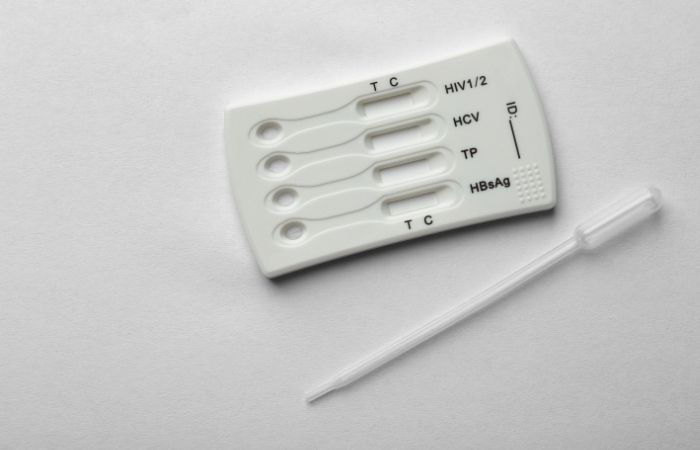Yes, You Can Get an STD Without Sex, Here's What to Know
The “Still a Virgin” Myth That Gets People Infected
One of the most dangerous lies about STDs? That if you haven’t had “real sex,” you’re not at risk. This myth is everywhere, in sex ed classrooms, in purity culture, and even in casual hookup culture where oral is brushed off like it doesn’t count.
But here’s the truth: STDs don’t care what you call it. If fluids or skin meet, there’s risk. In fact, many people contract their first STI during oral sex or non-penetrative genital contact. Herpes and HPV are especially notorious for slipping past the no-intercourse rule.
And here’s the kicker, some of these infections are passed by people who don’t even know they have them. No symptoms, no signs. Just contagious skin or saliva that does the job silently.

People are also looking for: Can I get herpes from sharing a drink?
Oral Sex Is Still Sex (At Least to STDs)
Oral sex often gets a pass in conversations about “safe sex.” But it’s one of the most common ways people pick up infections, especially herpes, gonorrhea, and syphilis. And yes, you can get HPV in your throat.
Here’s what oral sex can transmit:
- Herpes (HSV-1 and HSV-2): Cold sores can infect genitals, and genital herpes can infect mouths.
- Gonorrhea: Can infect the throat and be passed back and forth.
- Syphilis: Oral contact with a syphilis sore can transmit the bacteria.
- HPV: Often symptomless, but linked to oral and cervical cancers.
Dental dams and condoms help, but most people skip them during oral. That’s why it’s one of the most common routes of transmission for STDs people didn’t see coming.
Skin-to-Skin: When Touch Alone Is Enough
You don’t even need fluid exchange for some STDs to spread. Just friction. Skin-to-skin contact, think grinding, outercourse, or even intense cuddling naked, can transmit infections like:
- Herpes: Even when no sores are visible, the virus can live on the skin and be transmitted through genital rubbing or contact.
- HPV: Spread through microscopic cuts in the skin, especially in areas not covered by condoms (like the base of the penis or inner thighs).
- Molluscum contagiosum: A lesser-known viral infection spread through close physical contact, including dry humping.
And remember: condoms only protect what they cover. If the infected skin is outside the condom’s range, the risk remains.
Shared Sex Toys: The Unwashed Truth
Sex toys can carry more than just vibes, they can carry viruses and bacteria, too. Sharing unclean toys between partners can transmit:
- Chlamydia
- Gonorrhea
- HIV (rare but possible with blood exposure)
- Herpes
- Trichomoniasis
If a toy is inserted in one person and then another without proper cleaning or a new condom cover, it becomes a high-risk surface. Even solo toys can reintroduce bacteria if not cleaned regularly.
What helps? Condoms on toys, thorough cleaning between uses, and never sharing insertables without protection, especially during breakouts or known infections.
Check Your STD Status in Minutes
Test at Home with Remedium7-in-1 STD Test Kit

 For Men & Women
For Men & Women Results in Minutes
Results in Minutes No Lab Needed
No Lab Needed Private & Discreet
Private & DiscreetOrder Now $129.00 $343.00
For all 7 tests
Kissing Isn’t Always Harmless
Kissing might feel innocent, and most of the time, it is. But not always. Deep, open-mouth kissing (especially with broken skin or sores) can pass herpes and, in rare cases, syphilis.
Oral Herpes (HSV-1) is the main culprit here. One kiss from someone with an active cold sore (or even viral shedding without symptoms) can transmit the virus. Once you have it, you carry it for life, and you can spread it even when you’re not visibly broken out.
Syphilis transmission through kissing is less common, but it can happen, especially if one person has a chancre (syphilis sore) in or around the mouth. That’s not fear-mongering; it’s microbiology. The bacteria doesn’t need penetration, it just needs contact.
So while kissing usually isn’t something to stress over, it’s not entirely risk-free, especially if someone has symptoms or recent exposures.
“Just Rubbing” Can Still Be Risky
If you’re thinking, “But we only rubbed against each other with clothes on,” your risk is low. But skin-to-skin genital contact without penetration is another story entirely.
Dry humping while naked, grinding in your underwear, or “outercourse” where fluids or genital skin meet, all come with some level of risk. Especially for:
- HPV: Can transmit via tiny skin abrasions or direct contact.
- Herpes: Often passed through contact with skin, not semen or vaginal fluids.
- Molluscum contagiosum: Transmits via body contact and shared towels, not just sex.
Many people report getting STDs from partners they “didn’t even sleep with,” and this is exactly how. The body doesn’t care about technical definitions, it only cares about contact, exposure, and entry points.
No Symptoms ≠ No Infection
Here’s the trap: most people wait for something to burn, itch, or ooze before they even think about testing. But many of the most common STDs don’t show symptoms at all, or they show up so mildly that you miss them.
Infections like chlamydia, gonorrhea, and even HIV can sit silently in your body for weeks, months, or even years. During that time, you’re still contagious, and at risk for long-term health issues like pelvic inflammatory disease, infertility, or immune damage.
That’s why testing isn’t just for people with symptoms. It’s for anyone who’s been exposed, especially through non-penetrative contact most people write off as “safe.”

People are also looking for: How soon do STD symptoms appear?
Condoms Help, But They Don’t Cover Everything
Condoms are amazing at reducing risk. They protect against fluid-based infections like HIV and Gonorrhea really well. But they’re not perfect shields. Here’s where they fall short:
- Skin exposure: Condoms don’t cover all the skin that might carry or transmit Herpes or HPV.
- Oral sex: Many people skip protection during oral entirely.
- Toy sharing: Unless you’re using a new condom for each person, toys can transmit infections too.
The point isn’t to ditch condoms, it’s to use them with full awareness of what they do and don’t do. And to pair them with regular testing for maximum protection.
FAQs
1. Can I get an STD without having sex?
Yes. Many STDs like Herpes, HPV, Gonorrhea, and Syphilis can spread through oral sex, skin contact, or shared sex toys, even without penetration.
2. What’s the riskiest non-intercourse activity?
Oral sex is one of the most common non-intercourse transmission routes. Skin-to-skin rubbing and toy sharing can also carry significant risk.
3. Can kissing really give you an STD?
Yes. Kissing can transmit Herpes (HSV-1) and, in rare cases, Syphilis, especially if there are mouth sores or broken skin involved.
4. Do condoms protect against skin-transmitted STDs?
Not completely. Condoms reduce risk but don’t cover all exposed skin. STDs like Herpes and HPV can still spread from uncovered areas.
5. How often should I test if I’m not having penetrative sex?
Anyone who’s sexually active, oral, rubbing, toys, should test every 6 to 12 months, or sooner if they’ve had a new or risky encounter.
6. What are signs of STDs from oral or skin contact?
You might see sores, redness, or unusual discharge, but many people have no symptoms. That’s why testing is crucial.
7. sex toys carry STDs between people?
Yes. Toys can transmit STDs if not cleaned or covered between uses. Always wash thoroughly and use new condoms if sharing.
8. Is it possible to get an STD from clothing or towels?
Very unlikely. STDs don’t survive well on surfaces. But Molluscum contagiosum and some skin conditions may pass through shared items.
9. Can you get Herpes from someone with no visible sores?
Yes. Herpes can be spread during “viral shedding,” even when there are no symptoms. This is a major reason it spreads silently.
10. How can I tell if I have an STD if I don’t have symptoms?
You can’t. The only way to know for sure is through testing. Most STDs are silent in early stages but still contagious.
Knowledge Is Protection
You don’t need to “go all the way” to get an STD, and you don’t need to wait for symptoms to take control of your health. Oral sex, rubbing, skin contact, and even toy use can quietly transmit infections that change lives. But the power to protect yourself is real, and it starts with awareness and action.
Forget the shame, forget the outdated myths. Whether you’re curious, cautious, or recently exposed, the smartest thing you can do is know your status and act early. Because no matter how it happened, you deserve clarity, care, and confidence moving forward.
Sources
1. Sex and Travel – CDC (tripling of STI risk with casual sex abroad; pack condoms)
2. Pre-travel advice linked to lower STI risk among travelers – PMC
3. Can You Get an STD Through Clothing? – MedicineNet (pubic lice, scabies, but not typical STIs)
5. Trichomoniasis – ASHA (including survival on damp fabric; non-sex infection possible)
Written by M.D.F. Davis., reviewed by Dr. Alex Hart, MPH










